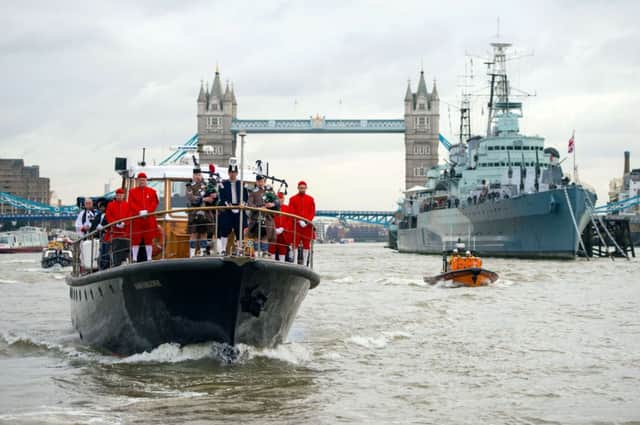50th anniversary of Churchill’s funeral marked


And 75 years since his “finest hour” when his rousing speeches galvanised a nation to defeat the Nazis, his descendants travelled the Thames on the boat that carried the statesman’s coffin on 30 January 1965.
Randolph Churchill, paying tribute to his great-grandfather, who served twice as prime minister (1940-45 and 1951-55) and was Tory MP for Dundee between 1908 and 1922.
Advertisement
Hide AdAdvertisement
Hide Ad“Here we are today, 50 years on, in what Churchill referred to as the ‘broad sunlit uplands’, and what’s sad is that we are losing that remarkable generation that served us so well in two world wars,” he said as he laid flowers at a statue of Churchill in Parliament Square in London. “It is wonderful to mark this point and remember those heroes.”
Westminster’s three main party leaders laid wreaths at his Commons statue.
Wreaths were also laid by Commons Speaker John Bercow, his Lords counterpart Baroness d’Souza and Tory MP Sir Nicholas Soames – Churchill’s grandson – after a service in parliament’s St Mary’s Undercroft chapel.
Crowds later gathered at London’s Tower Bridge to watch a flotilla – including Havengore, the barge which carried the coffin following Churchill’s state funeral at St Paul’s Cathedral – recreate his final journey.
Nine of his descendants were aboard as the bridge was raised for the teak vessel to pass.
One of the most poignant images of the pageantry 50 years ago was the lowering of cranes by London’s dockers as the coffin passed by. Yesterday phones, tablets and cameras were raised to capture the memory.
Churchill will be remembered for his stirring oratory including his famous “We shall fight them on the beaches” speech (1940), and “Never despair” (1955) about the hydrogen bomb.
Among those looking back on that momentous day was 92-year-old Harry Nunn, from Dundee, who led the horse-drawn carriage Churchill’s widow and family were travelling in behind the gun carriage bearing the war leader’s lead-lined and flag-draped carriage.
Advertisement
Hide AdAdvertisement
Hide AdMr Nunn, a groom at the Royal Mews in London, had served in the army during the Second World War and briefly came face-to-face with Churchill a few weeks before the D-Day landings. He was chosen for one of the most important jobs in the funeral because of his familiarity with a young horse making its first public appearance.
Mr Nunn said: “You could see the cortege in front of you the whole time. What amazed me was I’d never seen so many people. Right from when we came out of the House of Lords, along Whitehall and all the way up, it was chock-a-block. And when you left St Paul’s to go down to the boat, there were just as many people.”
Churchill had regarded Dundee as a “seat for life” but was defeated when prohibitionist Edwin Scrymgeour swept to victory.
He said: “I found myself without an office, without a seat, without a party and without an appendix.”
At the National Railway Museum in York the train which took the coffin from London to the family vault at St Martin’s Church in the village of Bladon, Oxfordshire – including a locomotive named Winston Churchill in his honour – was reassembled for the first time.
US ambassador Matthew Barzun commemorated the anniversary – which coincided with the 133rd anniversary of the birth of Churchill’s US wartime counterpart, president Franklin D Roosevelt – at a statue of the two men in London’s Bond Street.
Sir Nicholas, who walked behind the carriage bearing his grandfather’s coffin 50 years ago, said that day was “awe-inspiring”. He added: “The streets were 30 or 40 deep, full of people, wherever you looked. What was so extraordinary was to see the faces of people literally contorted with grief.”
‘We can all draw on his courage and resolve’
BRITAIN must draw on the “courage and resolve” inspired by Winston Churchill to battle the affronts to freedom faced today, David Cameron declared on the 50th anniversary of the wartime leader’s state funeral.
Advertisement
Hide AdAdvertisement
Hide AdThe Prime Minister paid tribute to “a great leader and a great Briton” after laying a wreath at the feet of the statue of his illustrious predecessor in the House of Commons Members’ Lobby as part of a day of commemorative events.
Churchill is still remembered with affection by the country as a statesman, bon viveur and reformer, Mr Cameron said, but most of all as a patriot – with lessons to teach the modern world.
“He knew Britain was not just a place on the map but a force in the world, with a destiny to shape events and a duty to stand up for freedom,” he said in the shadow of the famous bronze sculpture of Churchill. “That is why in 1940 – after France had fallen, before America or Russia had entered the war – he said this: ‘Hitler knows that he will have to break us in this island or lose the war. If we can stand up to him all Europe may be free – and the life of the world may move forward into broad, sunlit uplands.’
“Churchill was confident that freedom and democracy would win out over barbarism and tyranny… and it did.
“And with every affront to freedom in this century, we must remember that courage and resolve in the last century.”
FOLLOW US
SCOTSMAN TABLET AND MOBILE APPS